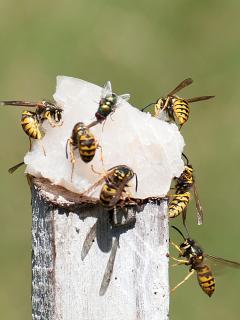Community surveillance and trapping for European wasps is sought by the Department of Agriculture and Food as new nests develop and become more active with the onset of warm, sunny weather.
The call for community help to complement department efforts follows capture of the first European wasp for the season in a department trap in Welshpool, which indicates there’s an active nest in the area.
European wasps are established in the Eastern States and each year fertilised queen wasps hitch a ride to Western Australia on freight and cargo and start new nests.
Department senior technical officer Marc Widmer said work would now commence on finding the European wasp nest using raw fish lures, and destroying it before it grew larger.
“Since 1977, the department has successfully eradicated European wasp incursions and prevented the pests’ establishment in WA,” Mr Widmer said.
“The success of the department’s European wasp surveillance program can be largely attributed to the support of the community and local government in surveillance activities.
“In 2011, the department implemented the ‘Adopt-a-Trap' initiative to supplement its own surveillance grid of more than 750 traps, resulting in a positive community response that saw community members and local governments install and check traps.
“Awareness and trapping by stakeholders greatly improves the detection and eradication of new nests, and helps prevent the wasp from establishing in WA.
“So far, more than 500 traps have been ‘adopted’ in Western Australia.”
People who ‘Adopt-a-Trap’ are asked to hang it in their garden with a raw fish lure that is replaced every fortnight, and to regularly check it for wasps and report trapped wasps to the department.
When a trapped wasp is confirmed to be a European wasp, the department locates and destroys the nest, and sets up traps in the area to help ensure any other nearby nests are found.
Last season the department destroyed 84 nests, the majority of which were found in the City of Cockburn and the industrial suburbs Welshpool and Kewdale.
Four nests were found in the regional area of Kalgoorlie-Boulder, and there was a high risk some nests in the area remained undetected last season, which meant fertilised queens could emerge this year and start new nests.
“European wasps threaten Western Australia’s horticulture, viticulture and apiculture industries,” he said.
“If they were to establish in WA, they would also affect our outdoor lifestyle, tourism industry, human health and the wellbeing of pets and livestock.”
European wasps have a thick-body and are about the same size and shape as a honey bee. They are a bright lemon-yellow colour with black stripes and yellow legs, and their antennae are entirely black.
They fly swiftly with their legs tucked up close to their body and their nests are usually built into the ground and are large, housing thousands of wasps.
The pest wasps are scavengers, so if any wasp settles on pet food, fish or other meat products, this should be considered suspicious and reported immediately to the department to investigate.
More information about the ‘Adopt-a-Trap’ initiative is available on the Department of Agriculture and Food website. The non-toxic traps are free and available by calling freecall 1800 084 881, your local department office, or by emailing info@agric.wa.gov.au.
Any suspect European wasp sighting should be reported to the Department’s Pest and Disease Information Service (PaDIS) on freecall 1800 084 881 or email info@agric.wa.gov.au


Media contacts: Dionne Tindale/Jodie Thomson, media liaison +61 (0)8 9368 3937

